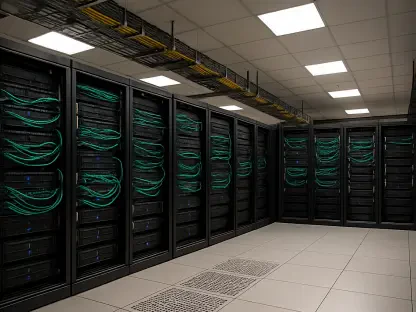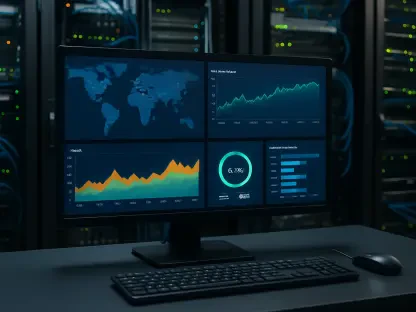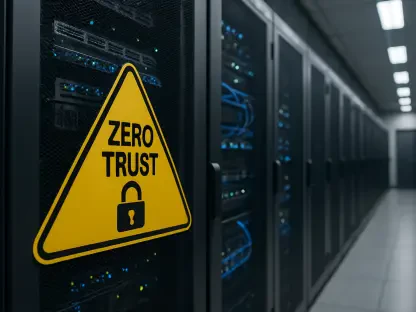Imagine a digital battlefield where a staggering 11.5 Terabits per second (Tbps) of malicious traffic surges toward a single target, aiming to cripple its online presence in mere seconds, an event that recently unfolded as the largest distributed denial-of-service (DDoS) attack ever recorded. At the forefront of this defense stands Cloudflare, a titan in internet infrastructure and security, whose advanced mitigation technology neutralized this unprecedented threat. This review delves into the intricacies of Cloudflare’s DDoS protection, examining its core features, real-world performance against record-breaking assaults, and its pivotal role in safeguarding the internet amidst an escalating cyber threat landscape.
Overview of Cloudflare’s Role in Cybersecurity
Cloudflare has cemented its position as a leading provider of internet infrastructure and security solutions, protecting millions of websites and applications across the globe. With a vast network spanning numerous data centers, the company serves as a critical shield against DDoS attacks, which aim to overwhelm online services by flooding them with illegitimate traffic. Its mission is to ensure uninterrupted access to digital resources, even under the most intense cyber assaults, by leveraging cutting-edge technology and a globally distributed infrastructure.
The essence of DDoS mitigation lies in identifying malicious traffic patterns and neutralizing them before they can cause harm. Cloudflare’s approach integrates sophisticated traffic analysis with rapid response mechanisms, addressing the growing sophistication of attacks that exploit diverse sources like Internet of Things (IoT) devices and cloud platforms. As cyber threats continue to evolve, the company’s role in the broader cybersecurity ecosystem becomes ever more vital, offering robust defenses that adapt to new challenges in real time.
This review aims to unpack how Cloudflare’s technology stands up to hyper-volumetric attacks and emerging attack vectors. By exploring its autonomous systems and global network capabilities, a clearer picture emerges of how this technology not only responds to current threats but also anticipates future risks, shaping the trajectory of internet security for businesses and users alike.
Key Features of Cloudflare’s DDoS Mitigation Technology
Autonomous Detection and Rapid Response
A hallmark of Cloudflare’s DDoS protection is its ability to detect and mitigate attacks autonomously, eliminating the need for manual intervention. This capability relies on advanced algorithms that monitor traffic patterns continuously, identifying anomalies that signal potential threats. Such automation proved crucial in handling the colossal 11.5 Tbps attack, where response times were measured in seconds, ensuring minimal disruption to the targeted service.
Underpinning this system are sophisticated anomaly detection tools that analyze incoming data for irregularities, distinguishing between legitimate user activity and malicious floods. The precision of these tools is evident in performance metrics, with mitigation accuracy remaining high even under extreme pressure. This reliability allows businesses to trust Cloudflare’s defenses, knowing that threats are addressed swiftly and effectively without compromising service availability.
The significance of autonomous response extends beyond individual attacks to the broader challenge of managing multiple simultaneous threats. By automating mitigation at scale, Cloudflare ensures that its vast network of protected sites remains resilient, even as attackers deploy increasingly complex strategies to bypass traditional defenses. This feature sets a benchmark for modern cybersecurity solutions.
Mastery Over Hyper-Volumetric Threats
Hyper-volumetric DDoS attacks, characterized by overwhelming traffic volumes, pose a unique challenge to online infrastructure. Cloudflare’s technology excels in managing such threats, as demonstrated by its successful mitigation of the record-breaking 11.5 Tbps UDP flood attack, which also reached a staggering packet rate of 5.1 billion packets per second. This capability highlights the robustness of its global network in absorbing and dispersing massive traffic spikes.
The technical prowess behind this defense lies in Cloudflare’s distributed architecture, which spreads attack traffic across numerous data centers to prevent any single point of failure. During the 11.5 Tbps assault, this approach ensured that the target remained operational despite the intensity of the UDP flood. A similar feat was achieved just months earlier with a 7.3 Tbps attack on a hosting provider, where over 37.4 Terabytes of traffic were neutralized in under a minute.
Beyond raw capacity, Cloudflare’s ability to adapt to the nuances of hyper-volumetric attacks underscores its effectiveness. By analyzing attack characteristics in real time, the system fine-tunes its response to mitigate specific threats like UDP floods, which aim to exhaust server resources with small, rapid packets. This adaptability is key to maintaining uptime for critical online services under siege.
Evolving Landscape of DDoS Threats
The frequency and scale of DDoS attacks have surged dramatically in recent times, with Cloudflare reporting 27.8 million attacks in the first half of this year alone, surpassing the total for the entire previous year. This alarming trend reflects a broader shift in cybercriminal tactics, where attackers leverage larger volumes of traffic to overwhelm targets. The escalation poses significant risks to businesses reliant on constant online availability.
Emerging attack vectors further complicate the threat landscape, with IoT devices and cloud infrastructure becoming prime tools for launching assaults. Attackers exploit these diverse sources to create distributed networks of malicious traffic, as seen in the 11.5 Tbps attack that involved multiple cloud providers and connected devices. This diversification makes traditional mitigation strategies less effective, pushing the industry toward more dynamic solutions.
The shift toward hyper-volumetric UDP flood strategies also signals a strategic evolution among cybercriminals, who prioritize maximum disruption with minimal effort. These trends are driving innovation in mitigation technologies, compelling providers like Cloudflare to enhance their defenses continually. As attack methods grow more sophisticated, the need for collaborative efforts across the cybersecurity sector becomes increasingly apparent to address shared vulnerabilities.
Real-World Performance and Sector-Wide Impact
Cloudflare’s DDoS mitigation technology has proven its worth across various industries, from e-commerce platforms to hosting providers and critical online services. Its ability to protect high-traffic environments ensures that businesses can operate without fear of downtime, even during peak attack periods. This broad applicability makes it a cornerstone for sectors dependent on digital continuity.
Specific case studies highlight the real-world impact of these defenses, such as the mitigation of the 11.5 Tbps attack, which targeted a major online entity with unprecedented force. Similarly, the earlier 7.3 Tbps assault on a hosting provider demonstrated Cloudflare’s capacity to handle massive traffic volumes—equivalent to thousands of high-definition movies—without faltering. These instances affirm the technology’s reliability under extreme conditions.
Unique use cases further illustrate Cloudflare’s versatility, such as safeguarding high-profile events with significant online engagement or defending against politically motivated cyberattacks. By ensuring uptime during such critical moments, the technology not only protects individual organizations but also contributes to the stability of the wider internet ecosystem, reinforcing trust in digital platforms across diverse contexts.
Challenges and Limitations in Mitigation Efforts
Despite its successes, Cloudflare faces substantial challenges in combating the sheer scale of hyper-volumetric attacks that push the boundaries of current technology. The intensity of threats like the 11.5 Tbps UDP flood tests the limits of even the most advanced systems, requiring constant innovation to stay ahead of attackers who adapt rapidly to defensive measures.
One notable limitation lies in distinguishing legitimate traffic from malicious surges during massive attacks, a complex task that can occasionally lead to false positives or delays in response. This issue becomes particularly pronounced when attackers use diverse sources like IoT devices to mask their activities, blending malicious packets with genuine user requests. Addressing this requires ongoing refinement of detection algorithms.
To counter these challenges, Cloudflare actively collaborates with other cloud providers, such as Google Cloud, to tackle shared vulnerabilities and enhance collective defenses. These partnerships aim to mitigate the exploitation of cloud infrastructure for attacks, fostering a united front against evolving threats. Such efforts are essential to overcoming the limitations inherent in facing a dynamic and resourceful adversary.
Future Prospects for DDoS Defense Innovation
Looking ahead, Cloudflare’s DDoS mitigation technology is poised for significant advancements, particularly through the integration of machine learning and predictive analytics. These innovations could enable preemptive threat identification, allowing the system to neutralize attacks before they fully materialize. Such progress would mark a shift from reactive to proactive defense strategies.
The long-term impact of escalating cyber threats will likely drive further investment in adaptive and scalable solutions. As attack volumes continue to break records, Cloudflare is well-positioned to lead the charge in developing defenses that can handle future challenges, potentially setting new standards for the industry. This trajectory suggests a future where cybersecurity becomes increasingly anticipatory rather than remedial.
On a broader scale, the societal implications of robust DDoS protection are profound, as sustained internet security underpins digital economies and critical infrastructure. Cloudflare’s potential to innovate in this space could influence how governments and organizations approach cyber resilience, ensuring that the internet remains a reliable foundation for global connectivity and commerce in the years ahead.
Final Thoughts and Recommendations
Reflecting on the evaluation, Cloudflare’s DDoS mitigation technology stands as a formidable barrier against some of the most intense cyber assaults recorded, including the historic 11.5 Tbps attack. Its autonomous detection and global network capacity demonstrate remarkable effectiveness, safeguarding critical online services during moments of extreme adversity. Yet, the persistent evolution of attack strategies underscores the ongoing challenges that demand constant vigilance and adaptation.
Moving forward, stakeholders in the cybersecurity ecosystem should prioritize investment in predictive technologies that anticipate threats before they strike, building on Cloudflare’s existing framework. Collaborative initiatives with other cloud providers must expand to address the exploitation of diverse attack sources, ensuring a fortified defense across platforms. These steps could help mitigate the risks posed by increasingly sophisticated adversaries.
Additionally, organizations relying on digital infrastructure should consider integrating layered security measures alongside solutions like Cloudflare’s, preparing for the inevitable escalation of cyber warfare. By fostering a culture of proactive defense and cross-industry cooperation, the groundwork is laid for a more resilient internet, capable of withstanding the challenges of tomorrow’s digital landscape.









